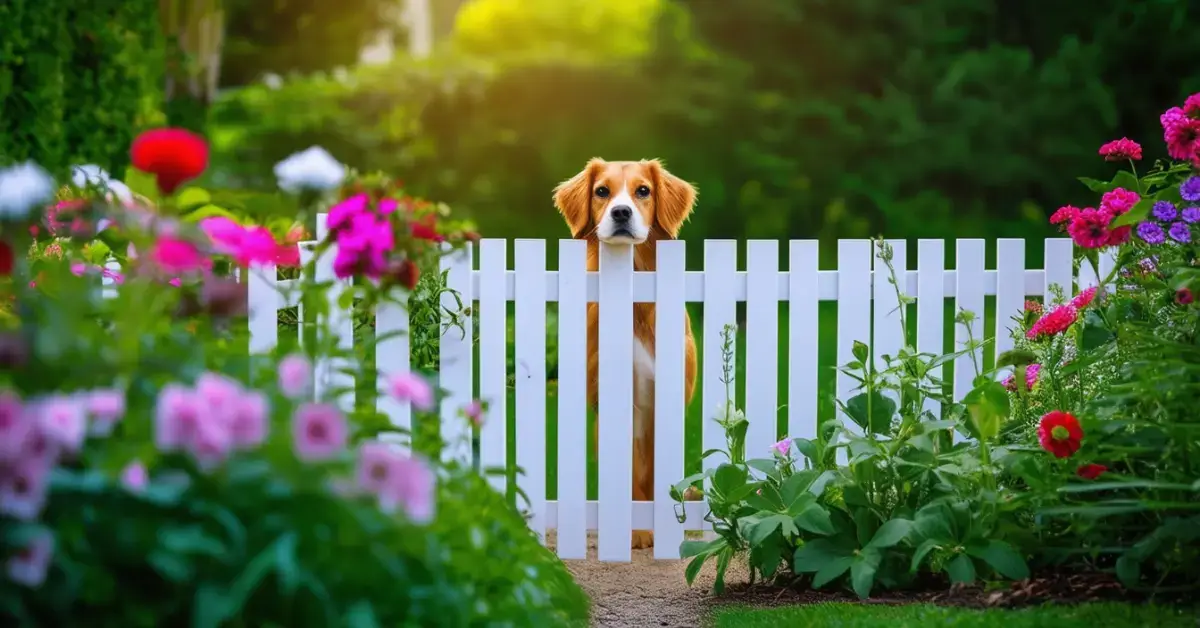You can keep dogs out of your garden by combining physical barriers, repellent plants, training, and noise and water deterrents. Start by installing a sturdy fence, at least 3 feet high, around your garden’s perimeter.
Plant strong-smelling herbs like lavender, rosemary, or chamomile to create a natural barrier. Train your dog by setting boundaries and rewarding good behavior. Use noise and water deterrents like ultrasonic devices, audible alarms, and motion-activated sprinklers to scare dogs away.
By using these methods together, you’ll create a multi-layered defense system to keep dogs out. Take the next step to learn how to design a dog-free zone tailored to your garden’s unique needs.
Key Takeaways
- Install physical barriers like fences, walls, or screens around the garden perimeter to block dog access.
- Plant strong-scented plants like lavender, rosemary, and marigolds around the garden to repel dogs naturally.
- Use training and redirection techniques, such as setting boundaries and providing alternative activities, to keep dogs away from the garden.
- Employ noise deterrents like ultrasonic devices, audible alarms, and motion-activated sprinklers to scare dogs away from the garden.
- Combine multiple methods, including physical barriers, plant-based deterrents, and noise deterrents, for a multi-layered defense against canine intruders.
Physical Barriers for Dog Deterrent

To prevent your furry friend from trampling your prized petunias, consider installing physical barriers that block access to your garden, such as fences, walls, or screens that surround the perimeter or specific areas.
This is an effective way to keep dogs out of your garden without harming them. Garden fencing is a popular option, as it clearly marks the boundary between your garden and the surrounding area.
You can choose from various materials, such as wood, metal, or vinyl, depending on your budget and personal preference.
When installing a fence, make sure it’s at least 3 feet high to prevent jumping. You can also add a gate that allows you to enter and exit the garden while keeping your dog out.
Another option is to use boundary marking, which involves placing physical markers around the garden perimeter to deter dogs from entering.
This can be as simple as placing sticks or flags around the garden or using more elaborate systems like electric fencing.
Repellent Plants for Dog Control
As you explore natural ways to keep dogs out of your garden, you’ll find that certain plants can be a powerful tool in your arsenal.
You can strategically plant strong-smelling species that dogs find unpleasant, creating a natural barrier that will deter them from entering your garden.
Natural Deterrent Options
You can effectively keep dogs out of your garden by incorporating certain plants that naturally repel them, with some of these plants even serving as a physical barrier.
These natural deterrents can be just as effective as commercial products like citrus sprays and ultrasonic devices.

For instance, lavender and rosemary are known to repel dogs due to their strong scents. Planting these around the perimeter of your garden can create a dog-deterrent border.
Marigolds, with their bright orange and yellow flowers, are another option. Not only do they repel dogs, but they also add a pop of color to your garden.
Other plants like chamomile, sage, and mint can also be used to keep dogs at bay.
These plants are easy to incorporate into your existing garden design and can be used in combination with other methods to create a dog-free zone.
Strong Smell Plants

Strong-smelling plants like garlic, hot peppers, and onions have natural oils that are overwhelming to a dog’s sensitive sense of smell, making them effective repellents.
These plants can be strategically placed around the perimeter of your garden to deter dogs from entering.
To maximize their effectiveness, you’ll want to choose a scent variety that’s potent and unpleasant for dogs.
Plant breeding has led to the development of even stronger-scented varieties, making them even more effective at repelling dogs.
You can plant them in containers or directly in the ground, depending on the type of plant and your garden’s layout.
Training Your Dog to Stay Away

For a successful training process, start by identifying the specific areas of your garden that you want to protect from your dog’s attention.
Once you’ve pinpointed these zones, it’s time to set boundaries. Establish a clear ‘no-go’ area by marking the perimeter with physical barriers, such as baby gates or fencing. This visual cue will help your dog understand what’s off-limits.
Next, implement a reward system to encourage good behavior. Whenever your dog ignores the forbidden area, reward them with treats, praise, or playtime. This positive reinforcement will help them associate staying away from the garden with positive outcomes.
Be consistent in your rewards, and your dog will quickly learn to respect the boundaries you’ve set.
Remember to supervise your dog during the training process, especially in the early stages. As they become more comfortable with the new rules, you can gradually give them more freedom in the garden.
With patience, persistence, and positive reinforcement, you can train your dog to stay away from your prized garden.
Redirecting Your Dog’s Attention

By redirecting your dog’s attention to an alternative activity or area, you can further reinforce the boundaries you’ve set and keep them occupied away from your garden.
This can be achieved through toy substitution, where you replace the tempting garden with a more appealing toy or treat. For example, if your dog loves to dig, provide them with a sandbox or a designated digging area filled with toys and treats. This won’t only keep them occupied but also satisfy their natural instinct.
Another effective way to redirect your dog’s attention is through sensory integration. Dogs have a strong sense of smell and enjoy exploring different textures and sensations.
Create a sensory experience for your dog by hiding treats or toys with strong scents, or by providing them with different textures such as sand, rice, or beans to dig through. This will engage their senses and keep them away from your garden.
Creating a Dog-Free Zone

As you work to create a dog-free zone in your garden, you’ll want to focus on three key areas.
Using dog deterrent methods to discourage your furry friend from entering the area is crucial.
Installing physical barriers to block access is another important step.
Selecting plants that are unappealing to dogs will also help to keep them away.
By combining these strategies, you’ll be well on your way to a dog-free garden oasis.
Dog Deterrent Methods
You can create a dog-free zone in your garden by employing a combination of physical barriers, repellents, and psychological deterrents that make your garden an uninviting space for dogs.
Understanding dog psychology is essential in keeping them out of your garden. Dogs are naturally curious and love to explore, but they’re also sensitive to smells, sounds, and visual cues.
By exploiting these weaknesses, you can create a garden that’s unappealing to them. For instance, you can use citrus sprays or vinegar-based repellents that dogs find unpleasant.
You can also use motion-activated sprinklers or ultrasonic devices that emit frequencies undetectable to humans but unpleasant for dogs.
Additionally, owner accountability plays a significant role in keeping dogs out of your garden. By educating dog owners about the importance of keeping their pets on a leash or under control, you can prevent unwanted intrusions.
Physical Barriers Work
To create a dog-free zone, install physical barriers around your garden, such as fencing, hedges, or walls, that are at least 3 feet high and difficult for dogs to climb or jump over.
This will help set clear boundaries and keep unwanted furry visitors out of your garden.
When choosing garden fencing, opt for durable materials like wood, metal, or vinyl that can withstand dog attempts to dig, chew, or jump over.
Consider the type of dog you’re trying to keep out and adjust the barrier’s height and material accordingly.
For example, if you’re dealing with smaller breeds, a 3-foot fence might suffice, but larger breeds may require a taller fence or additional deterrents.
Plant Selection Matters
Choosing dog-deterrent plants can be a clever addition to your garden’s defense, as certain species naturally repel canine visitors.
You can strategically plant these species around the perimeter of your garden to create a dog-free zone. For instance, lavender and rosemary are known to repel dogs, and they thrive in well-draining soil with full sun.
Consider your soil type and preferences when selecting dog-deterrent plants. If your soil is heavy clay, opt for plants like mint or lemongrass, which can tolerate wetter conditions. On the other hand, if your soil is sandy, plants like chamomile or marigold will do well.
Companion planting can also enhance the effectiveness of dog-deterrent plants. Planting strong-scented herbs like thyme or oregano alongside dog-deterrent plants can amplify their repelling properties.
By incorporating these plants into your garden design, you’ll create a multi-layered defense against canine intruders. Remember to plant them strategically, taking into account factors like sunlight, soil preferences, and growth habits.
With careful planning, you can create a garden that’s both beautiful and dog-free. By combining dog-deterrent plants with other defense strategies, you’ll be well on your way to a peaceful and protected garden oasis.
Using Noise to Deter Dogs

The loud, high-pitched sounds from ultrasonic dog repellent devices can be an effective way to deter dogs from entering your garden.
These devices emit a frequency that’s undetectable to humans but unpleasant for dogs, making them an attractive solution for dog owners and garden enthusiasts alike.
You can place these devices around the perimeter of your garden or in areas where dogs are most likely to enter.
In addition to ultrasonic devices, audible alarms can also be used to scare dogs away.
These alarms are triggered by motion sensors, emitting a loud, startling sound when a dog approaches.
You can place these alarms near gates, fences, or other entry points to deter dogs from entering your garden.
When choosing an audible alarm, look for one that’s weather-resistant and adjustable, so you can customize the sensitivity and volume to your needs.
Remember to position your noise-deterrent devices strategically to maximize their effectiveness.
Motion-Activated Sprinklers

You can install motion-activated sprinklers around your garden’s perimeter to startle dogs with a sudden burst of water when they approach. This humane and effective deterrent will keep dogs away from your garden without causing them harm.
When selecting motion-activated sprinklers, consider the following factors:
Sprinkler Placement: Place sprinklers at regular intervals around your garden’s perimeter, guaranteeing they cover all entry points.
Water Pressure: Choose sprinklers that can handle your water pressure, as high pressure can lead to wasted water and ineffective deterrence.
Adjustable Sensitivity: Opt for sprinklers with adjustable sensitivity to minimize false triggers and conserve water.
Proper installation and placement of motion-activated sprinklers will guarantee that your garden remains dog-free. By startling dogs with a sudden burst of water, you can protect your garden without harming them.
With the right sprinklers and placement, you can enjoy a dog-free garden without the hassle of constant supervision.
Fencing Options for Garden Protection
Encircling your garden with the right type of fencing can be a highly effective way to keep dogs out.
When choosing a fence, consider the type of dog you’re trying to keep out and the layout of your garden. For instance, if you have a small garden with defined garden borders, a shorter fence may be sufficient. However, if you have a larger garden or are dealing with larger breeds, you’ll want to opt for a taller fence.
The type of fence material you choose is also essential.
Wooden fences, like cedar or pine, are attractive and durable options. Metal fences, such as aluminum or steel, are also effective and can be more budget-friendly. Vinyl fencing is another popular choice, as it’s low-maintenance and resistant to weathering.
Whichever material you choose, make sure it’s sturdy enough to withstand potential jumping or digging attempts. Consider combining your fence with other deterrents, like motion-activated sprinklers, for added protection.
What tricks do you use to keep dogs out of your garden? Let me know.





